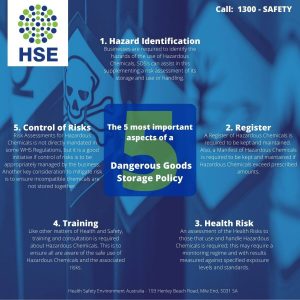Home » Occupational Hygiene » Dangerous Goods Storage & Handling Assessment
Dangerous Goods Storage & Handling Assessment
Dangerous goods are substances and articles potentially hazardous to people, property and the environment. They are classified based on their immediate physical or chemical effects, such as susceptibility to fire, explosion, causing corrosion, oxidation, spontaneous combustion or poisoning. Whatever their properties and their potential for injury and destruction, care is needed in their transport, storage and handling.
HSE Australia can assess if dangerous goods stored in the workplace are done so in accordance with regulatory requirements.
Contact us if you are in any doubt about the quantity, storage or handling of dangerous goods at your workplace.
Our services include:
Our experts conduct a first visual review to evaluate the risk of taking samples.
If declared safe, our qualified and experienced Occupational Hygienist will take samples.
Lab analysis of samples taken during the assessment will be analysed in our NATA accredited laboratory
Request a Quote
Please provide us with some details.

Dangerous Goods - Storage & Handling Assessments
HSE Australia can conduct a dangerous goods risk assessment and provide detailed reports with executive summaries and recommendations that prioritise safety issues and support your compliance program.
Businesses must manage the risks associated with the handling, storage and transportation of dangerous goods. Safety and management regulations require that hazardous goods (e.g., certain chemicals and gases) be stored in accordance with the law. Significant penalties exist for organisations that fail to comply with dangerous goods storage and handling regulations.
An assessment involves:
- checking the quantity and types of dangerous goods
- checking how and where these goods are stored
- ensuring quantities do not exceed regulatory storage quantities
- checking the storage of chemicals that are incompatible with each other
- verifying that bunding requirements and emergency procedures are in place to manage possible spills or leaks adequately.
Assessment, Sampling & Analysis of Dangerous Goods
HSE Australia offers a wide range of Occupation Hygiene and Risk Management Services in the area of Dangerous Goods and Hazardous Material. Get in touch for an individual quote.
Request a call back
Solving problems others find difficult...for clients in
The 5 most important aspects of a Dangerous Goods Storage Policy
Five key points about storing & handling dangerous goods and hazardous substances:
Many businesses knowingly or unknowingly deal with substances that can be identified as “Dangerous Goods” or “Hazardous Chemicals”. These substances can range from simple cleaning agents or disinfectants to highly reactive chemicals such as Acetone or Mercury. Therefore, we'd like to provide you with some basic information about five most important aspects of dangerous goods storage policies and procedures. While most companies don’t need detailed policy and procedures to be implemented, over the years our consultants have encountered businesses that where completely unaware of the fact that some of the material they stored and that their staff were working with on a daily basis might have been identified as potentially harmful and indeed hazardous. Therefore, we recommend reviewing your business arrangements and to implement at least a broad “Hazardous Chemicals Storage and Use Procedure” where this is applicable. Note that ‘Dangerous Goods’ are actually called ‘Hazardous Chemicals’ in some WHS regs. Probably for most novices Hazardous Chemicals and Dangerous Goods are the same. Dangerous Goods often refers to transport of DG.
1. Hazard Identification
Businesses are required to identify the hazards of the use of Hazardous Chemicals, SDS’s can assist in this supplementing a risk assessment of its storage and use or handling.
2. Register
A Register of Hazardous Chemicals is required to be kept and maintained. Also, a Manifest of Hazardous Chemicals is required to be kept and maintained if Hazardous Chemicals exceed prescribed amounts.
3. Health Risk
An assessment of the Health Risks to those that use and handle Hazardous Chemicals is required; this may require a monitoring regime and with results measured against specified exposure levels and standards.
4. Training
Like other matters of Health and Safety, training and consultation is required about Hazardous Chemicals. This is to ensure all are aware of the safe use of Hazardous Chemicals and the associated risks.
5. Control of Risk
Risk Assessments for Hazardous Chemicals is not directly mandated in some WHS Regulations, but it is a good initiative if control of risks is to be appropriately managed by the business. Another key consideration to mitigate risk is to ensure incompatible chemicals are not stored together.

Frequently asked Questions
Health Safety Environment Australia
What are Dangerous Goods?
Dangerous Goods (DGs) are chemicals which have been classified as being a hazard according to specific criteria and are required to be stored and transported in a specific way depending on the hazards they pose.
What are Hazardous Chemicals?
Hazardous chemicals pose physical and/or health hazards, they are classified under the Globally Harmonised System of Classification (GHS). All DGs are Hazardous Chemicals, but not all Hazardous Chemicals are DGs.
How is a risk assessment done?
An Occupational Hygienist will identify the hazards e.g. chemical exposure, noise , dusts fumes, then collect personal exposure samples and analyse those samples in a laboratory and compare the results to Workplace or Regulatory Exposure Limits.
Who is allowed to handle Dangerous Good?
At workplaces, workers who have had training to minimise any risks posed by Hazardous Chemicals and use the correct PPE can handle Hazardous Chemicals.
Can we use a Hazardous Chemicals Register Template?
And do you provide a Hazardous Chemical Register Template for download? HSE Australia can provide you with a basic template to support you in your aim to create a safe workplace. However, it is your responsibility as an organisation or PCBU to understand and comply with WHS regulations regarding the storage and handling of Dangerous Goods. This register template can only by a small part of your effort to keeping your workers safe. Therefore, we recommend a professional assessment of your workplace.
Please download the document here: Hazardous Chemicals Substances Register Template PDF
One Source Many Solutions
Over the past 15 years we developed the ability to quickly understand and respond to our clients’ needs. We are “solving problems others find difficult…”.
We offer our clients an enviable team of specialists working with associates and other external experts, driving and delivering fit for purpose, tailored single sourced solutions for you.









